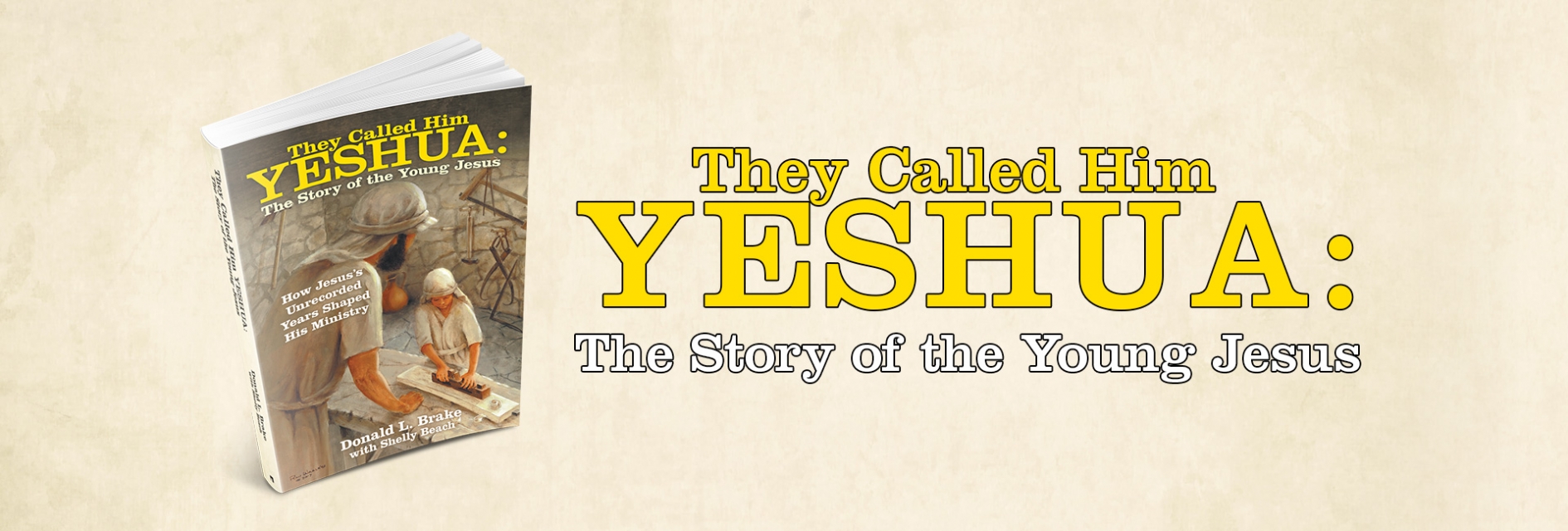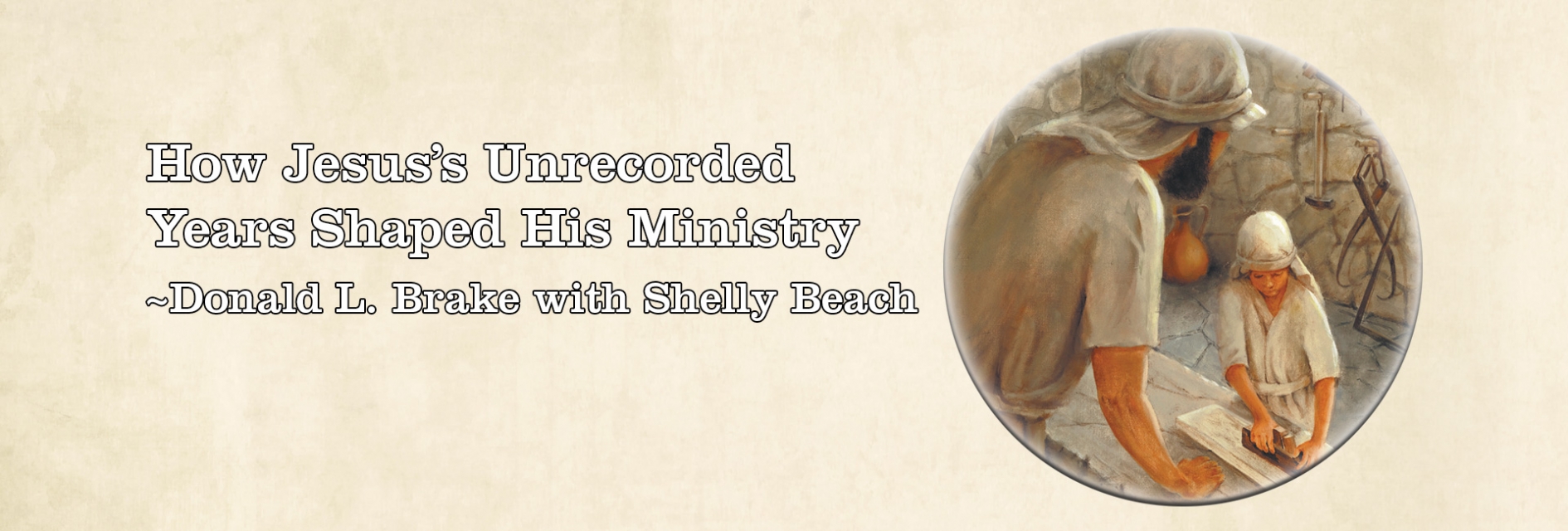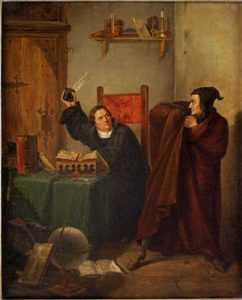

 Written by Donald Brake Oct 22, 2019
Written by Donald Brake Oct 22, 2019
LEWISVILLE, TX: While Halloween glorifies ghosts and goblins, death and mayhem, and maybe entertaining, don’t miss one of the most important events in Christian history: Martin Luther’s nailing of the 95-Thesis protesting the selling of indulgences to absolve purchasers from sin.
All Souls’ (Saints) Day (November 1) is a Roman Catholic, Anglican and some Protestants’ celebration of Christian saints.
The celebration is reminiscent of the Celtic festival Samhain (following the last harvest and anticipating the dark second-half of the year), with bonfires, parades, and dressing in costumes as saints or devils became All-hallowmas day (meaning all saints). The night before, October 31, first known as All-Hallows Eve before its more common name Halloween.
Martin Luther battles the Devil (Public Domain)
On October 31, 1517, Luther tacked a document on the Wittenberg Castle Church’s door attacking the Roman Catholic Church’s corrupt practices. Thus sparking the Protestant Reformation. While most of the theses focused on selling indulgences, the central issues coming out of the 95 Theses were the authority of the Bible (sola scriptura), and salvation by faith alone (sola fide) through God’s grace without the aid of “righteous” deeds. The attack on the Pope included his taking money from the poor to fill Rome’s coffers.
The 86th thesis charges that the pope should re-build St. Peter’s Basilica with his own money. Luther accused the pope of using the money obtained from poor believers to build St. Peter’s.
However, the 95 theses did not come as a sudden thought of Luther. It came out of the underlying changing culture that was gripping Europe. The soil was tilled and ready for a new seed of reform in Europe’s political and religious society.
The economic factor
The national rulers, nobles and middle class of the new nation-states in Western Europe regarded the land possessed by the Roman Church with greedy eyes. The rulers resented the loss of the money that went to Rome’s papal treasury and that the wealthy clergy was exempt from taxes.
Celebrating the ancient origins of Halloween and Samhain
Inflation had grown out of control across Europe. The indulgence system was Rome’s way of supplying the coffers and lining their own pockets. The growing dissatisfaction brought Europe to a boiling point.
The political factor
The new centralized nation-states were opposed to the concept of a universal church that claimed jurisdiction over the national state and its powerful rulers. Nations who accepted Protestantism were outside the old Roman Empire and the powerful middle classes challenged the reigning cultural outlook.
The new moral/intellectual factor
The new thinking from humanistic scholars clearly saw the discrepancies between the Roman Catholic Church’s teaching based on tradition and papal authority and that which the rediscovered Greek New Testament taught. Corruption had entered the hierarchy with priests buying and selling religious offices freely, collecting salaries without work, and the courts selling justice. Many priests lived in open sin or kept concubines while the people’s needs were neglected.
Major areas Luther reformed:
Distinctions between Clergy, Priests and Monks. The Scriptures claim all believers are priests, therefore Monks do not get merit for righteous works. There is no biblical support for Monks to have life-long vows of celibacy, poverty or obedience as holy merit. They should just minister to the people.
Authority resides in the Bible. The new thought pointed out that popes and councils make mistakes but God remains true.
Indulgences. The poor and underclasses received extra grace at the behest of the pope. If the Pope had such authority, Luther argued, then why doesn’t the Pope forgive all? Indulgences were a money-making proposition and not a biblical notion.
Sacraments.
- a) Mass became the Lord’s Table
b) Marriage as a sacrament is not in the Bible
c) Last rites are a mere superstition
d) Baptism is not for merit, but a grace of God.
Separation of Church and State.
Although Luther is the modern face of the Protestant Reformation and lauded for his work as a theologian, he was at odds with some of his protestant successors over separation of church and state: John Calvin, Philip Melanchthon, and Huldrych Zwingli.
In his early life, Luther supported the European Jews because of their anti-Catholic views. Later in life, some suggest, because he was not able to convert Jews to Christianity, he became an outspoken anti-Semitic.
Separation of Church and State: Another Law School For You
In our modern politically correct society, Luther has been vilified for his stance and that it led some to criticize him for the emergence of Adolph Hitler.
In 1946, Julius Streicher was on trial for his life at the Nuremberg trial. Bernard N. Howard in an article Luther’s Jewish Problem quotes Streicher’s testimony:
“In the book The Jews and Their Lies (1543), Dr. Martin Luther writes that the Jews are a serpent’s brood and one should burn down their synagogues and destroy them. Dr. Martin Luther would very probably sit in my place in the defendants’ dock today if this book had been taken into consideration by the Prosecution.”
With Luther’s indefensible anti-Semitism and his undeniable influence on Christianity, let’s honor him for his German translation of the Bible, his unwavering stand for sola scriptura and sola fide, the release of monks and nuns from cloistered lives, mandated celibacy and the freedom from the chains of righteous deeds for redemption.
But let’s remember Luther was a human and as such a sinner with weaknesses and blind spots that can’t be celebrated.
Using Halloween language: The ghost of Martin Luther still “haunts” the sacred sanctuaries of Christianity as both a saint and a sinner.
Lead Image: Public Domain: Luther at the Battle of the Worms by Gemälde von Anton von Werner (1843–1915)
About the Author
Written by Donald L. Brake Sr.
Donald L. Brake Sr., PhD, Dallas Theological Seminary; Dean Emeritus, Multnomah Biblical Seminary of Multnomah University. A former pastor, he lives with wife Carol, in Lewisville, Texas. The author has served as a Missionary in Ethiopia, SIM; Professor of Theology, Multnomah Biblical Seminary; Pastor, North Carrollton Baptist Church; President, Institute of Holy Land Studies (now Jerusalem University College; and dean Multnomah Biblical Seminary; and co-founder Living Word Bible Museum. He currently is a freelance writer. The author’s experience as president of the Institute in Jerusalem has given him insight into the historical, cultural, and geographical background of Israel and the life of Christ. Dr. Brake has led tours to the Holy Land and has taught the life of Christ and the Bible’s historical/cultural backgrounds for more than thirty-five years. Dr. Brake wrote a series of fifteen articles for the St. Louis Metro Voice and has published the Wycliffe New Testament. His book A Visual History of the English Bible was published in 2008 (a 2009 Evangelical Christian Publishers Association Christian Book Award finalist); Jesus, a Visual History with Todd Bolen, 2014; A Monarch’s Majestic Translation, in 2017; and A Visual History of the King James Bible, in 2011 (with Shelly Beach; also translated into Portuguese as "Uma Historia Visual Da Biblia King James"), a commemorative edition celebrating four hundred years of the King James Version. His major article “Versions, English” was published in The Interpreters Dictionary of the Bible, vol. volume 5, Abington Press. His most recent work is They Called Him Yeshua: the Story of the Young Jesus, 2019.


